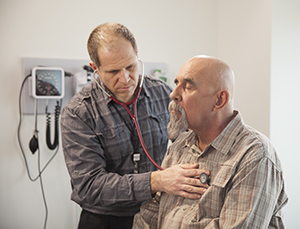Walking Pneumonia (Mycoplasma Pneumonia)
Walking Pneumonia (Mycoplasma Pneumonia)
What is walking pneumonia?
Pneumonia is an infection of one or both of the lungs. It's usually caused by a virus, or bacteria. Walking pneumonia is caused by a specific bacteria called mycoplasma. Pneumonia can be very serious, especially in infants, young children, and older adults. And also in those with other long-term health problems or weak immune systems. In otherwise healthy adults, pneumonia can be mild. Mycoplasma pneumonia is a mild form and is often called walking pneumonia.
What are the symptoms of walking pneumonia?
The most common symptom is a dry, hacking cough. You may also feel tired.
Other symptoms may include:
Fever
Headaches
Chills
Sweating
Chest pain
Ear pain
Sore throat
How is walking pneumonia diagnosed?
Your healthcare provider will ask about your medical history and current symptoms. He or she will also examine you. You may also have tests including:
Imaging. A chest X-ray of your chest may be done.
Lab tests. Blood tests and sputum cultures may be done.
How is walking pneumonia treated?
Since it's caused by bacteria, antibiotics are usually prescribed. However, it may also go away without any treatment.
Your healthcare provider may also recommend medicines, either prescription or over-the-counter, and other measures to relieve symptoms such as:
Acetaminophen or ibuprofen to lower your fever and lessen headache or other pain
Cough medicine to loosen mucus or reduce coughing
Bedrest or reduced activity
Increased fluids to loosen mucus and replace lost fluids from sweating
Make sure you check with your healthcare provider or pharmacist before taking any over-the-counter medicines.
What are the complications of walking pneumonia?
Although walking pneumonia is usually mild, and it often goes away without treatment, complications can occur. They include:
Severe pneumonia
Serious infections in other parts of the body
Anemia or a low red blood cell count
Kidney problems
Skin conditions
What can I do to prevent walking pneumonia?
To prevent others from getting walking pneumonia:
Try to stay away from other people if you are coughing a lot.
Cover your mouth when you cough. It's easy to pass along this infection to other people through coughing, and contact with surfaces that you cough near.
Wipe off surfaces, including phones, remote controls, and doorknobs with antibacterial or disinfectant products.
Tell people to wash their hands if they touch things you have coughed near.
Make sure to wash your hands often. Wash them before handling food or objects that others may touch. Use a separate towel or paper towels for drying.
Updated:
February 16, 2018
Sources:
Bono. Mycoplasmal Pneumonia. Medscape (2013), Learn About Pneumonia, American Lung Association, Mycoplasma pneumonia infection in children, Up TO Date, Pneumonia Symptoms, Causes, and Risk Factors, American Lung Associaiton
Reviewed By:
Adler, Liora, C., MD,Fetterman, Anne, RN, BSN,Image reviewed by StayWell art team.
